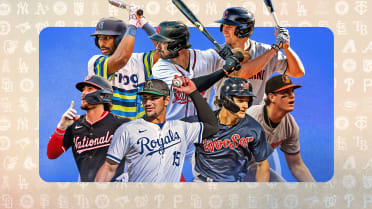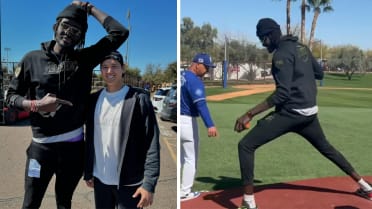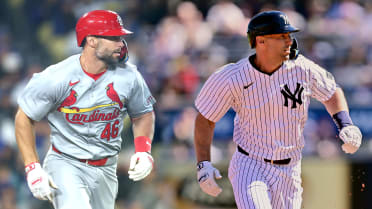How strike zone change would affect pitchers
MLB has reportedly proposed raising zone above knees
The baseball world was buzzing on Monday afternoon with a report from ESPN's Jayson Stark -- and since confirmed by MLB.com's Jon Paul Morosi -- that Major League Baseball made a proposal to the MLB Players Association that included the idea of raising the bottom of the strike zone from "the hollow beneath the kneecap" to "the top of the hitter's knees."
It's not a given that the union would agree, because the same thing happened last year, and nothing came of it. But it's clear now that the sport would like to see it happen, so let's dig into the data and help understand not just why, but what might happen -- and who might be affected.
The "why," anyway, is simple. Though the recent home run surge has helped put some offense back in the game, baseball continues to see record-setting strikeout totals. It's not just that the 21.1 percent of plate appearances that ended in a strikeout in 2016 were a new record, it's that it was the 10th straight season in which the mark either increased or held steady. Some of that is due to ever-increasing pitcher velocity, to be sure, and some of it is because strikeouts no longer carry the stigma they once did, at least for power hitters, but the strike zone is also a factor.
According to Jon Roegele's research at The Hardball Times, the strike zone ended at 21 inches off the ground in 2009, or 1.75 feet. Since then, the strike zone has slowly expanded downward, and in '16, pitchers could often get strikes called up to three inches below that.
The idea, in theory, is that by raising the strike zone, hitters would get fewer low called strikes. They could lay off those unhittable 97 mph sinkers that they can't touch anyway. In turn, pitchers would be forced to come higher up, giving batters additional hittable pitches in the zone. The intent, it seems, is to generate more swings, more contact, and more action -- though there's obvious risk that if hitters just swing at fewer pitches overall, we'll end up with more walks.
So if this happens, which pitchers may be affected? And how much? While it's more complicated than you'd think, because not every hitter's zone is the same size, we can still run some numbers.
Let's start with the 21-inch lower border that we established in '09, and we'll look at the three inches below that, which is the expanded zone in Roegele's research. Who, in '16, threw the most pitches in that area?
Highest percentage of pitches 18-21 inches off ground, 2016
21.6 percent -- Brad Ziegler
19.0 percent -- Joe Smith
17.7 percent -- Steve Cishek
17.0 percent -- Chad Qualls
15.9 percent -- Matt Albers
15.2 percent -- Dan Otero
15.1 percent -- Andrew Miller
14.9 percent -- Kendall Graveman
14.9 percent -- Francisco Rodriguez
14.8 percent -- Alex Claudio
(Of 439 pitchers who threw at least 500 pitches in 2016)
Unsurprisingly, soft-tossing side-armers Ziegler and Smith live in this zone more than anyone else, because without overwhelming stuff or velocity, they have to be essentially pinpoint-perfect in order to generate the ground balls they survive on. Veteran righties Qualls, Albers and Otero all fit a similar profile in terms of generating grounders and soft contact, while not really missing bats, though the elite relief ace Miller jumps off the page here.
But we're not just looking at who lives there, we're looking at who succeeds there. Who gets the most called strikes in that zone? In theory, those called strikes would be balls, if this plan is approved, and flipping those away from strikes could have a big impact.
Most called strikes 18-21 inches off ground, 2016
83 -- Zach Davies
82 -- Kendall Graveman
79 -- Kyle Hendricks
75 -- Wade Miley
74 -- Jonathan Lester
72 -- Marco Estrada
72 -- Martin Perez
71 -- Jacob Arrieta
70 -- Jeremy Hellickson
69 -- Marcus Stroman
Now we're seeing some big names, including all three ace starters from the World Series-champion Cubs. The next 10 names include the likes of Jose Quintana, Cole Hamels and Dallas Keuchel, but with the exception of Arrieta, no one here truly blows you away with velocity. Instead, you have a collection of arms like Hendricks, Davies and Estrada, who succeed more with deception and placement than anything. You have less-heralded names like Graveman and Perez, who don't miss many bats and might not be able to survive in the bigs if any tools were taken away from them. Graveman had a 4.11 ERA last year; imagine if 82 of his strikes had been balls?
We've oversimplified, probably. For example, we haven't accounted for batter height or a catcher's pitch-framing skill -- and we don't know that these changes would add more contact to the game. But it does seem that for a certain class of pitchers, the softer-tossing control artists who have truly benefited by the southward movement in the strike zone over the past few years, such a change may not be met with joy. It could make some less effective; it could deprive others of the cushion they need to stick in the Majors at all
It's that push-and-pull which makes it interesting to see if the union will agree. Many pitchers, obviously, won't be in favor. But you can imagine that hitters would love it. After all, no one wants to watch an unhittable pitch at the ankles get called for strike three.
Mike Petriello is an analyst for MLB.com and the host of the Statcast podcast. He has previously written for ESPN Insider and FanGraphs.



